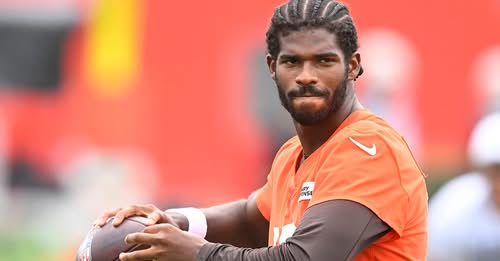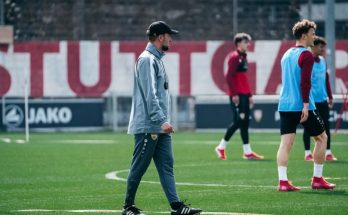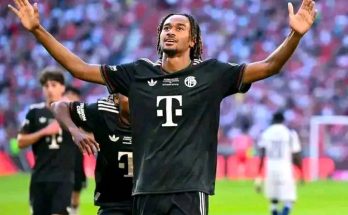**Without Heading**
Shortly after Cleveland Browns head coach Kevin Stefanski hinted at the possibility of starting quarterback Shedeur Sanders in another preseason game, the young signal-caller suffered an oblique injury, casting uncertainty over his immediate future. The incident has sparked discussions about player health, preseason risks, and the delicate balance between evaluating talent and protecting key players ahead of the regular season.
### **The Injury and Its Immediate Impact**
Shedeur Sanders, the highly-touted rookie quarterback out of the University of Colorado, had been turning heads during training camp with his poise, arm strength, and football IQ. His performance in the Browns’ first preseason game was solid, prompting Stefanski to consider giving him more snaps to further assess his readiness. However, during a routine practice session, Sanders felt a sharp pain in his side while throwing a deep pass. Medical staff quickly evaluated him and diagnosed an oblique strain, sidelining him indefinitely.
Oblique injuries, though not always severe, can be tricky for quarterbacks, as the muscle group is heavily involved in throwing motions. Recovery times vary, but even minor strains can take weeks to heal fully. For Sanders, this means missing valuable preseason reps—a crucial period for a rookie adjusting to the speed and complexity of the NFL.
### **Preseason Dilemma: Play or Protect?**
Stefanski’s initial inclination to play Sanders again highlights a common preseason debate: how much should teams risk their key players in exhibition games? Starters often see limited action to avoid unnecessary injuries, but for rookies and backups, these games are vital for development and evaluation.
The Browns, like many teams, must weigh the benefits of live-game experience against the potential cost of losing a player to injury. Sanders’ case is particularly delicate because he is seen as the future of the franchise, even if he begins the season as a backup to veteran Deshaun Watson. Losing him for an extended period could stunt his growth and force Cleveland to adjust its long-term plans.
### **Historical Context: Preseason Injuries and Their Consequences**
Sanders’ injury is far from an isolated incident. Over the years, several high-profile players have suffered significant injuries in preseason games, leading to debates about their necessity. In 2019, New York Giants wide receiver Sterling Shepard fractured his thumb in a preseason contest, while in 2015, then-Carolina Panthers quarterback Cam Newton took unnecessary hits in an exhibition game, raising concerns about his workload.
The NFL has already reduced the preseason schedule from four games to three, partly in response to player safety concerns. However, injuries still occur, and some argue that the league should further minimize preseason exposure or replace it with controlled scrimmages. Others contend that these games are essential for roster evaluation, especially for undrafted free agents and late-round picks fighting for spots.
### **Sanders’ Development and the Browns’ QB Situation**
Before the injury, Sanders was making a strong case to be Watson’s primary backup. His accuracy, decision-making, and mobility had impressed coaches, and many believed he could push veteran Jameis Winston for the No. 2 role. Now, his absence could open the door for Winston to solidify his position, leaving Sanders to play catch-up once healthy.
For a rookie quarterback, missing preseason reps is a significant setback. The speed of NFL defenses, the complexity of playbooks, and the chemistry with receivers are all aspects best developed in live action. If Sanders’ recovery takes longer than expected, the Browns may have to rely more on Watson and Winston early in the season, delaying Sanders’ potential debut.
### **Team and Fan Reactions**
The Browns’ fanbase, already anxious about the team’s Super Bowl aspirations, has expressed mixed reactions. Some criticize Stefanski for even considering playing Sanders in another preseason game, while others argue that injuries are an unavoidable part of football.
Teammates have rallied around Sanders, with Watson publicly supporting him and emphasizing the importance of patience in recovery. “Shedeur’s a tough kid,” Watson said. “He’ll bounce back stronger, and when he’s ready, he’ll show everyone why he belongs here.”
### **Looking Ahead: What’s Next for Sanders and the Browns?**
The immediate focus for Cleveland is ensuring Sanders’ full recovery before rushing him back. Oblique strains can linger if not properly treated, and the last thing the Browns want is a recurring issue. The team’s medical staff will likely take a cautious approach, possibly holding him out for the remainder of the preseason.
In the meantime, the Browns will continue evaluating their other quarterbacks, including Winston and undrafted rookie Dorian Thompson-Robinson. The coaching staff must also decide whether to keep Sanders as the third QB or place him on injured reserve if the recovery timeline extends into the regular season.
### **Final Thoughts**
Shedeur Sanders’ oblique injury serves as a reminder of the fine line NFL teams walk during the preseason. While these games are valuable for player evaluation and development, the risk of injury is ever-present. For Sanders, the setback is unfortunate but not insurmountable. With proper rehabilitation and support, he can still make an impact in his rookie year.
For the Browns, the situation reinforces the need for depth at quarterback. As they prepare for a potential playoff run, ensuring that Watson stays healthy—and that Sanders returns at full strength—will be critical. In the unpredictable world of the NFL, adaptability is key, and how Cleveland navigates this challenge could shape their season.
As fans await updates on Sanders’ status, one thing is clear: the preseason, while often dismissed as meaningless, carries real consequences. The Browns—and the entire league—must continue balancing opportunity with caution, because in football, the next play is never guaranteed.



